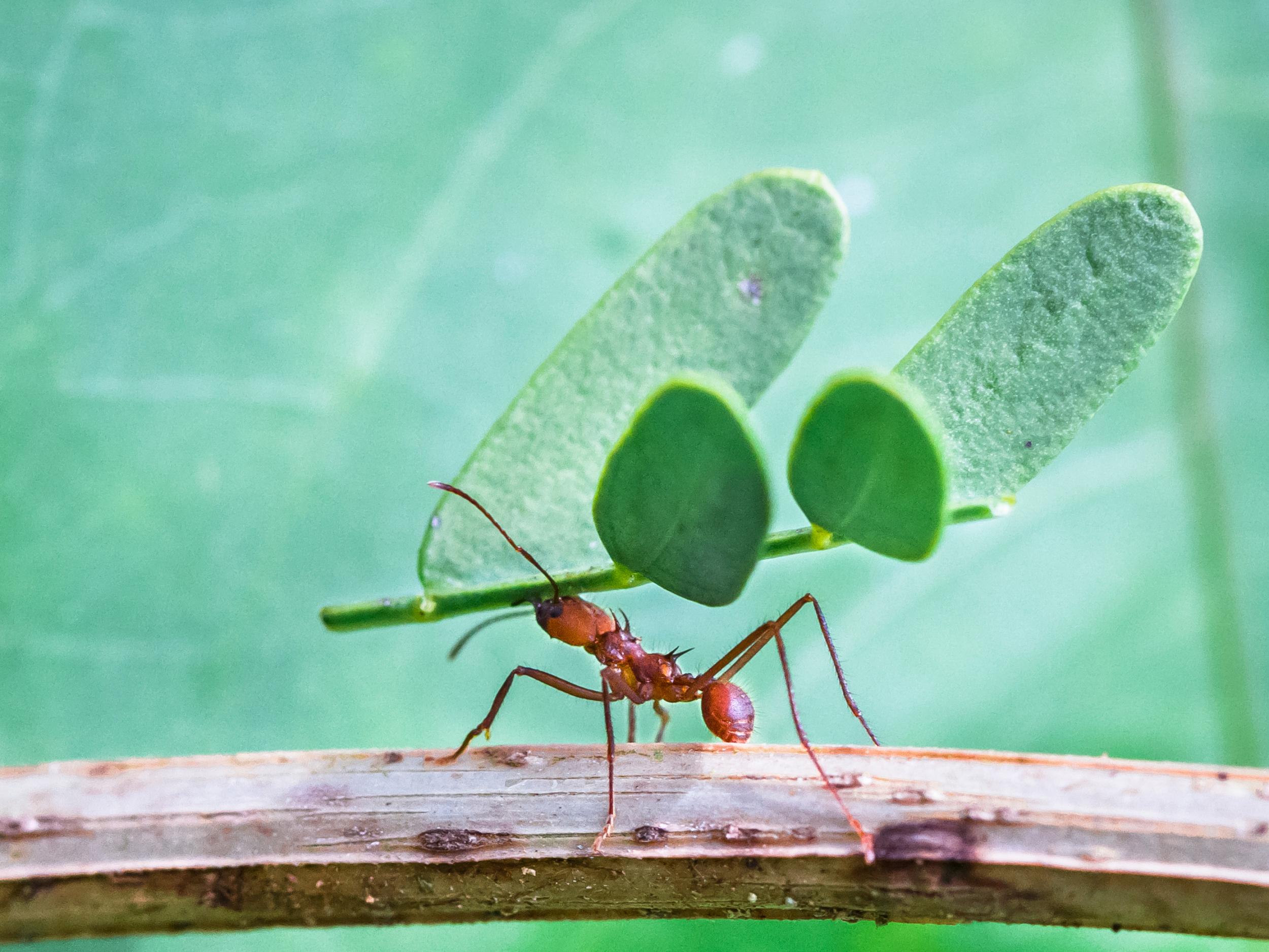The Independent's journalism is supported by our readers. When you purchase through links on our site, we may earn commission.
Leafcutter ants have evolved defences to fight parasitic fungus, study shows
The insects have been locked in a chemical arms race with the behaviour-modifying fungus for millions of years

On the face of it, a leafcutter ant’s nest is a perfect picture of harmonious relationships. Worker ants go out to forage for fresh leaf material that they use to grow a fungus (Leucoagaricus gonglyophorous).
In return for a mulchy compost of fresh leaves, the fungus breaks down the plant material to produce nutritious, edible structures which the ants can digest.
However, mine and my colleagues’ latest research suggests that this image ignores the chemical warfare being waged by leafcutter ants.
In reality, they are locked in an arms race with another, parasitic fungus called Escovopsis, which plagues the ants’ food source and appears to be using chemical weapons to modify ant behaviour.
As all farmers are well aware, crops are prone to outbreaks of disease. South American leafcutter ants face a similar problem in that their fungal gardens can become infested with parasites, usually other bacterial and fungal species that feed off the nutritious fungal crop.
Escovopsis, in particular, is specialised to grow on the leafcutter ant garden and can be devastating to an ant colony. It is sometimes so effective at invading the fungus that it can overwhelm the ant’s food source.
This causes many ants to die and the remaining individuals to eventually abandon their normally well-tended gardens altogether.
Several decades of research have shown that, over millions of years, the ants have evolved several lines of defence against Escovopsis infections.
The ants weed out pieces of infected fungus and can also produce several antimicrobial chemicals that they spread over the garden.
As well as producing their own forms of pesticide, the ants also commission the help of antibiotic-producing bacteria called Pseudonocardia, which they grow on their bodies and whose chemicals can inhibit the growth of Escovopsis.
But we now understand that this assortment of weaponry is only one side of an arms race.
Escovopsis has developed its own suite of chemical missiles that block ant defensive behaviours and kill the helpful antibiotic-producing bacteria. This explains how infections can escalate and eventually lead to colony collapse.
To identify the parasite’s arsenal, we grew Escovopsis either on its own or together with the ant food fungus. Chemical techniques called liquid chromatography and mass spectrometry were applied to identify and measure the amounts of particular molecules that the Escovopsis was producing.
We were able to isolate two families of chemical, called melinacidin IV and shearinine D, whose production increased once the food fungus was infected. Instructions to make both of these compounds were also found in the DNA of several different types of Escovopsis that all infect leafcutter ant colonies.
Melinacidins have previously been shown to kill certain groups of bacteria. We showed that melinacidin IV was indeed active against the antibiotic-producing Pseudonocardia bacteria, which grows on the ant cuticle and normally helps to protect the food fungus.
Beekeepers fume at association's endorsement of fatal insecticides
Show all 2Shearinine D also inhibited the growth of Pseudonocardia suggesting that the Escovopsis was producing chemicals to remove one of the ants’ key defence strategies.
Not only this, but when we fed shearinine D to the ants via a sugary solution it caused them to become disorientated and increasingly paralysed.
This indicates that Escovopsis may also prevent ants from carrying out their weeding behaviours. Continuous exposure to the chemical was ultimately fatal for the ants.
Interestingly, shearinine D is related to a compound produced by the “zombie ant” fungus (Ophiocordyceps unilateralis) that similarly manipulates the behaviour of tropical carpenter ants.
O unilateralis causes the ants to walk around randomly and eventually grip tightly to an elevated plant stem until they die. Fungus spores can then grow out of the ant and spread to the wider environment.
Together, melinacidin IV and shearinine D may help Escovopsis to overwhelm an ant colony. It is thought that under normal conditions, Escovopsis is largely kept at bay by the ant’s defences and only persists at low levels in the nest.
But when a colony comes under stress from other environmental problems such as a drought, Escovopsis may take advantage and begin to churn out chemical weapons that ultimately lead to colony collapse.
Our results provide evidence for the evolutionary arms race that is unravelling within leafcutter nests, as individuals fight over the fungal food.
Over millions of years, each player has evolved its own set of defences and weaponry to outcompete the other players.
Such arms races also play out in human infections, as disease-causing bacteria evolve resistance to antibiotic medicines. In response, we try to use new types of antibiotic to target the bacteria, and so the game continues.
As such, studying complex systems with several species competing against each other, such as leafcutter ant nests, could contribute to our search for new antibiotics as well as insecticides to control invasive ant species.
PhD student in molecular microbiology at the University of East Anglia. This article was originally published on The Conversation
Subscribe to Independent Premium to bookmark this article
Want to bookmark your favourite articles and stories to read or reference later? Start your Independent Premium subscription today.

Join our commenting forum
Join thought-provoking conversations, follow other Independent readers and see their replies